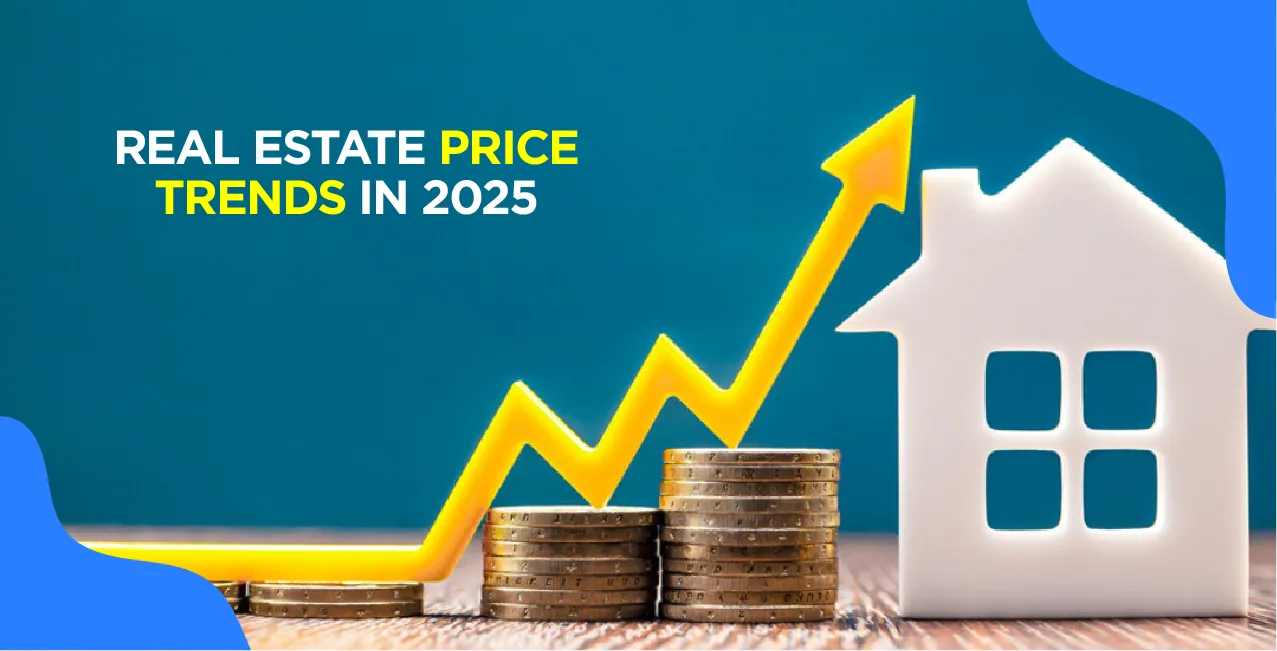
Author
LoansJagat Team
Read Time
12 Minute
03 Mar 2025
Real Estate Price Trends in 2025: Is It a Good Time to Invest?
Imagine a busy neighbourhood where, in just nine weeks, 173 luxury homes are built, each priced at around ₹66 crore. This isn't a scene from a distant land but from Gurugram, India, where DLF's "The Dahlias" project achieved sales of approximately ₹11,400 crore in such a short span.
This surge in high-end property sales reflects a broader trend in India's real estate market for 2025. Experts predict that average home prices will rise by 6.5% this year, primarily driven by affluent buyers.
While luxury housing flourishes, many middle and lower-income families find homeownership increasingly out of reach, leading to a growing demand for rental properties.
As the market evolves, potential investors face a pressing question: Is now the right time to invest in real estate? Understanding current trends and future projections is essential to making a decision in this era.
How Are Real Estate Price Trends Shaping Investment Decisions in 2025?
In 2025, real estate in India is buzzing with new opportunities and challenges.
Imagine this: A couple in Mumbai who bought a 2BHK flat for ₹1.2 crore in 2020 is now seeing offers of ₹1.8 crore for the same property. That’s a 50% growth in just five years! This kind of price rise is making many people think, “Is it the right time to invest in property?”
Real estate trends reflect changing lifestyles, economic shifts, and evolving buyer behaviour. In cities like Bengaluru, Hyderabad, and Pune, prices have been climbing steadily due to rising demand for IT hubs and better infrastructure.
Let’s find out the factors shaping these price trends and how they influence investment decisions.
Economic Factors Driving Real Estate Prices in 2025
Several economic factors are pushing real estate prices higher this year. Understanding these drivers will help investors make smarter choices.
1. Inflation and Rising Construction Costs
When inflation increases, the cost of building materials such as cement, steel, and bricks also rises.
For example, the price of cement, which was ₹370 per bag in 2023, has now touched ₹450 per bag in 2025. This rise directly increases property prices because builders pass on these costs to buyers.
2. Urbanisation and Population Growth
India’s growing urban population is another major reason for rising property prices. Cities like Hyderabad, Bengaluru, and Gurugram are expanding rapidly.
A young professional moving from a small town to Bengaluru for a tech job creates more demand for housing, driving prices higher.
3. Government Policies and Tax Incentives
Government policies also play a big role. For example, schemes like Pradhan Mantri Awas Yojana offer tax benefits for first-time homebuyers.
At the same time, cuts in stamp duty, like Maharashtra’s reduction from 5% to 3% make buying homes cheaper, encouraging more people
to invest.
Impact of Interest Rates on Property Investments
Interest rates are one of the biggest factors that affect property investments. When home loan interest rates rise, borrowing becomes more expensive. This can either slow down property purchases or push buyers toward more affordable housing options.
Why Do Interest Rates Matter?
Let’s say you take a home loan of ₹50 lakh for 20 years:
Interest Rate (%) | Monthly EMI (₹) | Total Interest Paid Over 20 Years (₹) |
8.50% | 43,391 | 54,13,745 |
9.00% | 45,000 | 58,00,226 |
9.50% | 46,653 | 62,02,829 |
A small increase of 0.5% in interest rates can increase your total interest payout by nearly ₹4 lakh! For homebuyers, this highlights the importance of securing a loan when interest rates are lower to save a significant amount over the long term.
What’s Happening in 2025?
In early 2025, the Reserve Bank of India (RBI) kept the repo rate steady at 6.5%. This has kept home loan rates around 8.5-9%, which is relatively high compared to past years. For investors, this means rental yields need to be higher to justify the cost of borrowing.
Location Matters More Than Ever
In 2025, location is still king. Properties in prime areas like South Delhi, Mumbai’s Bandra, or Bengaluru’s Whitefield are witnessing a sharp rise in prices. For example, a luxury apartment in Bandra that cost ₹5 crore in 2020 now sells for ₹7 crore.
However, upcoming areas on the city outskirts are becoming hotspots too. Areas like Hinjewadi in Pune or Electronic City in Bengaluru offer better returns for investors looking for affordable options with growth potential.
Housing Supply vs. Demand: What’s Changing This Year?
Imagine a young couple in Pune searching for their first home. They find that while there are plenty of luxury apartments available, affordable 2BHK flats are harder to come by. This is a clear example of how housing supply and demand are shifting in 2025.
In simple terms, supply refers to how many homes are available, while demand is the number of people who want to buy those homes. In 2025, demand for affordable housing is rising quickly, but the supply isn’t keeping up. Why?
- Urbanisation: More people are moving to cities for better jobs and lifestyles.
- Higher Income Levels: As incomes rise, more people can afford to buy homes, increasing demand.
- Limited Land Supply: Big cities like Mumbai and Bengaluru are running out of land for new developments, limiting the number of new homes being built.
This mismatch between supply and demand means home prices are going up, especially in major cities. According to recent reports, India’s urban housing shortage could cross 20 million units by the end of this year, mostly in affordable housing segments.
Regional Price Variations: Where Are the Hotspots?
Not all cities in India are seeing the same growth in property prices. Some regions are turning into real estate hotspots, while others remain stable. Here’s a simple breakdown of how prices are rising across different cities:
City | Average Price per sq. ft (₹) | Price Growth (2024-25) |
Mumbai | 22,000 | 8% |
Bengaluru | 12,500 | 10% |
Hyderabad | 11,000 | 12% |
Pune | 9,000 | 9% |
Chennai | 8,500 | 7% |
Why are these cities hotspots?
- Hyderabad: Growing IT sector and better infrastructure.
- Bengaluru: Expanding tech hubs and job opportunities.
- Mumbai: Limited land but high demand for premium properties.
On the other hand, cities like Kolkata and Jaipur are seeing slower price growth due to less demand and slower infrastructure development.
The Rise of Smart Cities and Its Impact on Property Value
Have you heard of cities like Dholera in Gujarat or GIFT City in Gandhinagar? These are examples of India’s new smart cities—urban spaces designed with modern infrastructure, digital services, and sustainable living.
In 2025, smart cities are becoming real estate game-changers. Here’s how:
- Better Connectivity: High-speed internet, smart transportation, and improved public services make these areas attractive for buyers.
- Higher Property Values: A 2BHK flat in a smart city like Dholera could cost around ₹40 lakh today but is expected to rise by 20% in the next three years.
- Sustainable Living: Green spaces, waste management systems, and energy-efficient buildings are attracting eco-conscious buyers.
For investors, this means putting money into smart cities now could lead to significant returns in the next 5–10 years. The government’s Smart Cities Mission is also boosting infrastructure spending, which will only increase property values in these areas.
Rental Yields in 2025: Better Than Buying?
Imagine Rahul, a young professional in Bengaluru, trying to decide whether to buy a flat or rent one. Buying a 2BHK apartment in a good area would cost him around ₹1 crore, but renting the same flat costs just ₹30,000 per month. This is a common dilemma for many Indians in 2025.
Rental yield is the annual rent you earn as a percentage of the property's value. In India, rental yields have traditionally been low—around 2-3%—but in 2025, things are changing.
Rental Yields in Major Indian Cities
City | Average Property Price (₹ per sq. ft.) | Rental Yield (%) |
Bengaluru | 12,500 | 5% |
Hyderabad | 11,000 | 4% |
Mumbai | 22,000 | 3% |
Pune | 9,000 | 4% |
Chennai | 8,500 | 4% |
With rental yields improving in cities like Bengaluru and Hyderabad, many investors are now considering rental income as a smarter option than buying property for long-term capital gains.
If property prices continue to rise faster than rents, buying may not offer the best returns in the short term.
When is renting better than buying?
- If you plan to stay for a short period (less than 5 years)
- When loan interest rates are high (currently around 8-9%)
- In cities where property prices are rising too quickly
Government Policies and Tax Reforms Affecting Real Estate
The Indian government plays a big role in shaping the real estate market. In 2025, several policies and tax reforms are influencing property investments.
Key Government Policies in 2025:
Policy/Initiative | Impact on Real Estate |
Pradhan Mantri Awas Yojana (PMAY) | Subsidies for affordable housing buyers |
GST Reforms on Real Estate | Reduced tax on under-construction properties |
Stamp Duty Reductions (State-specific) | Lowers the cost of property registration |
Real Estate Regulatory Act (RERA) | Increased transparency and accountability |
The extension of the PMAY scheme for urban areas has helped first-time homebuyers access affordable housing more easily.
Tax benefits on home loan interest and principal repayments under Section 80C and Section 24 also make buying property attractive for middle-class buyers.
Foreign Investment Trends: Is Global Capital Flowing In?
Foreign investment in Indian real estate has seen a high boost in 2025. Investors from countries like the UAE, Singapore, and the US are showing interest in commercial properties and luxury housing in Indian metro cities.
This surge in foreign investment is driven by India’s strong economic growth, favourable government policies, and the increasing demand for premium real estate in cities like Mumbai, Bengaluru, and Delhi NCR.
Factors such as the introduction of Real Estate Investment Trusts (REITs) and ease of doing business have further encouraged global investors.
For example, if an investor from the UAE puts ₹10 crore into a commercial property yielding 8% annual returns, they could earn ₹80 lakh per year in rental income. Over five years, this amounts to ₹4 crore, excluding capital appreciation.
With rising property values and rental yields, international investors view Indian real estate as a lucrative, long-term investment opportunity, making it a hotbed for global capital inflow.
Why is foreign capital flowing in?
- India’s stable economy and growing middle class
- Rising demand for commercial spaces in IT hubs
- Attractive returns from rental income in luxury housing
A prime example is the increase in investments from NRIs (Non-Resident Indians) in cities like Gurugram and Bengaluru.
An NRI investor from Dubai, for instance, might purchase a ₹5 crore apartment in Mumbai, expecting rental yields of 3-4% annually along with long-term capital appreciation.
Conclusion
Real estate investment in 2025 offers both risks and rewards. While rising prices and interest rates might seem intimidating, there are still plenty of opportunities if you research wisely. Start by evaluating your financial capacity, understanding market trends, and choosing the right location.
If you're buying a home or looking for a solid investment, India’s real estate market continues to be a dependable option, just make sure you time it right!
About the Author

LoansJagat Team
‘Simplify Finance for Everyone.’ This is the common goal of our team, as we try to explain any topic with relatable examples. From personal to business finance, managing EMIs to becoming debt-free, we do extensive research on each and every parameter, so you don’t have to. Scroll up and have a look at what 15+ years of experience in the BFSI sector looks like.

Quick Apply Loan
Subscribe Now


